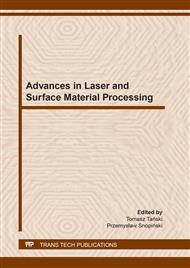[1]
A. Shrivastava, Plastics Processing, in. A. Shrivastava (Ed.), Introduction to Plastics Engineering, Elsevier Inc., 2018, pp.143-177.
DOI: 10.1016/b978-0-323-39500-7.00005-8
Google Scholar
[2]
J.R. Wagner Jr., E.M. Mount III, H.F. Giles Jr., Extrusion: The Definitive Processing Guide and Handbook, Elsevier Inc. (2016).
Google Scholar
[3]
R. Shanks, I. Kong, Thermoplastic Elastomers, InTech, (2012).
Google Scholar
[4]
M. Yakout, M.A. Elbestawi, S.C. Veldhuis, On the characterization of stainless steel 316L parts produced by selective laser melting, Int J Adv Manuf Technol 95 (2018) 1953-1974.
DOI: 10.1007/s00170-017-1303-0
Google Scholar
[5]
P. Razvan, P. Ancuta, Applications of the Selective Laser Melting Technology in the Industrial and Medical Fields, in: I. Shishkovsky (Ed.), New Trends in 3D Printing, Intech, 2016, pp.161-185.
Google Scholar
[6]
E. Koc, Y. Akca, Z.C. Oter, M. Coskun, Selective Laser Sintering of Aluminum Extrusion Dies, Technical Note Aluteam Tn-2016/001.
Google Scholar
[7]
B. Reggiani, L. Donati, Additive Manufacturing for Extrusion Dies, Light Metal Age, (2018), 14-18.
Google Scholar
[8]
M. Cortina, J.I. Arrizubieta, A. Calleja, E. Ukar, A. Alberdi, Case Study to Illustrate the Potential of Conformal Cooling Channels for Hot Stamping Dies Manufactured Using Hybrid Process of Laser Metal Deposition (LMD) and Milling, Metals 8/102 (2108) 1-15.
DOI: 10.3390/met8020102
Google Scholar
[9]
M.M. Kostic, L.G. Reifschneider, Design of Extrusion Dies, Encyclopedia of Chemical Processing (2006) 633-649.
Google Scholar
[10]
O.S. Carneiro, J. M. Nóbrega, Main Issues in the Design of Extrusion Tools, in: O.S. Carneiro, J.M. Nóbrega (Eds.), Design of Extrusion Forming Tools, Smithers Rapra Technology Ltd, Shropshire, 2012, pp.1-36.
Google Scholar
[11]
J.M. Nóbrega, O.S. Carneiro, Profile Forming Tools, in: O.S. Carneiro, J.M. Nóbrega (Eds), Design of Extrusion Forming Tools, Smithers Rapra Technology Ltd, Shropshire, 2012, pp.149-219.
Google Scholar
[12]
K.G. Kovalenko, V.I. Sivetskii, A.L. Sokol'skii, Design of an Extrusion Die for Plastic Profiles, Chemical and Petroleum Engineering, 49/9-10 (2014) 675-678.
DOI: 10.1007/s10556-014-9817-x
Google Scholar
[13]
A. Śliwa, W. Kwaśny, M. Sroka, R. Dziwis, Computer simulation of the aluminium extrusion process, Metalurgija 56/3-4 (2017) 422-424.
Google Scholar
[14]
W. Sha, Z. Guo, Maraging Steels: Modelling of Microstructure Properties and Applications, Woodhead Publishing Limited, (2009).
Google Scholar
[15]
S. Białasz, R. Pamies, Numerical Simulation of the Design of Extrusion Process of Polymeric Mini-Tubes, Applied Computer Science 14/3 (2018) 81-95.
DOI: 10.35784/acs-2018-23
Google Scholar
[16]
Information on https://www.solidthinking.com.
Google Scholar
[17]
Y. Mu, G. Zhao, A. Chen, X. Wu, Modeling and simulation of polymer melts flow in the extrusion process of plastic profile with metal insert, Int J Adv Manuf Technol 67 (2013) 629-646.
DOI: 10.1007/s00170-012-4511-7
Google Scholar
[18]
Information on http://www.compuplast.com.
Google Scholar
[19]
E.A. Jägle, Z. Sheng, P. Kürnsteiner, S. Ocylok, A. Weisheit, D. Raabe, Comparison of Maraging Steel Micro- and Nanostructure Produced Conventionally and by Laser Additive Manufacturing, Materials 10/1 (2017) 1-15.
DOI: 10.3390/ma10010008
Google Scholar
[20]
T. Bhardwaj, M. Shukla, Effect of laser scanning strategies on texture, physical and mechanical properties of laser sintered maraging steel, Mat. Sci. Eng. A-Struct. 734 (2018) 102-109.
DOI: 10.1016/j.msea.2018.07.089
Google Scholar
[21]
E.V. Pereloma, A. Shekhter, M.K. Miller, S.P. Ringer, Ageing behaviour of an Fe-20Ni-1.8Mn-1.6Ti-0.59Al (wt%) maraging alloy: Clustering, precipitation and hardening, Acta. Mater. 52/19 (2004) 5589-5602.
DOI: 10.1016/j.actamat.2004.08.018
Google Scholar
[22]
M. Sroka, A. Zieliński, M. Mikuła, The service life of the repair welded joint of Cr‑Mo / Cr-Mo-V, Arch Metall Mater 61/3 (2016) 969-974.
DOI: 10.1515/amm-2016-0217
Google Scholar
[23]
M. Sroka, M. Nabiałek, M. Szota, A. Zieliński, The influence of the temperature and ageing time on the NiCr23Co12Mo alloy microstructure, Rev Chim-Bucharest 4 (2017) 737-741.
DOI: 10.37358/rc.17.4.5541
Google Scholar
[24]
J. Stašić, D. Božić, Densification behavior of 316L-NiB stainless steel powder and surface morphology during selective laser melting process using pulsed Nd:YAG laser, Rapid Prototyping Journal 25/1 (2019) 47-54.
DOI: 10.1108/rpj-07-2017-0136
Google Scholar
[25]
R. Casati, J.N. Lemke, A. Tuissi, M. Vedani, Aging Behaviour and Mechanical Performance of 18-Ni 300 Steel Processed by Selective Laser Melting, 6 (2016) 1-13.
DOI: 10.3390/met6090218
Google Scholar
[26]
A.G. Demir, B. Previtali, Investigation of remelting and preheating in SLM of 18Ni300 maraging steel as corrective and preventive measures for porosity reduction, Int J Adv Manuf Technol 93 (2017) 2697–2709.
DOI: 10.1007/s00170-017-0697-z
Google Scholar
[27]
J. Mutua, S. Nakata, T. Onda, Z.C Chen, Optimization of selective laser melting parameters and influence of post heat treatment on microstructure and mechanical properties of maraging steel, Materials and Design, 139 (2018) 486-497.
DOI: 10.1016/j.matdes.2017.11.042
Google Scholar
[28]
N. Yesildag, Ch. Hopmann, Ch. Windeck, S. Bremen, K. Wissenbach, S. Merkt, Opportunities and Challenges of Profile Extrusion Dies Produced by Additive Manufacturing Processes, AIP Conference Proceedings (2017) 1-5.
DOI: 10.1063/1.5016712
Google Scholar
[29]
M. Król, J. Mazurkiewicz, S. Żołnierczyk, Optimization and analysis of porosity and roughness in selective laser melting 316L parts, Archives of Materials Science and Engineering 1/90 (2018) 5-15,.
DOI: 10.5604/01.3001.0012.0607
Google Scholar
[30]
M. Król, T. Tański, Surface Quality Research for Selective Laser Melting of Ti-6Al-4V Alloy, Archives of Metallurgy and Materials 61/3 (2016) 1291-1296.
DOI: 10.1515/amm-2016-0213
Google Scholar
[31]
M. Król, L.A. Dobrzański, Ł. Reimann, I. Czaja, Surface quality in selective laser melting of metal powders, Archives of Materials Science and Engineering 60/2 (2013) 87-92.
Google Scholar
[32]
M. Król, M. Kujawa, L.A. Dobrzańsi, T. Tański, Influence of technological parameters on additive manufacturing steel parts in Selective Laser Sintering, Archives of Materials Science and Engineering 67/2 (2014) 84-92.
Google Scholar
[33]
F. Calignano, D. Manfred, E.P. Ambrosio, L. Iuliano, P. Fino, Influence of process parameters on surface roughness of aluminum parts produced by DMLS, Int J Adv Manuf Technol 67 (2013) 2743-2751.
DOI: 10.1007/s00170-012-4688-9
Google Scholar


